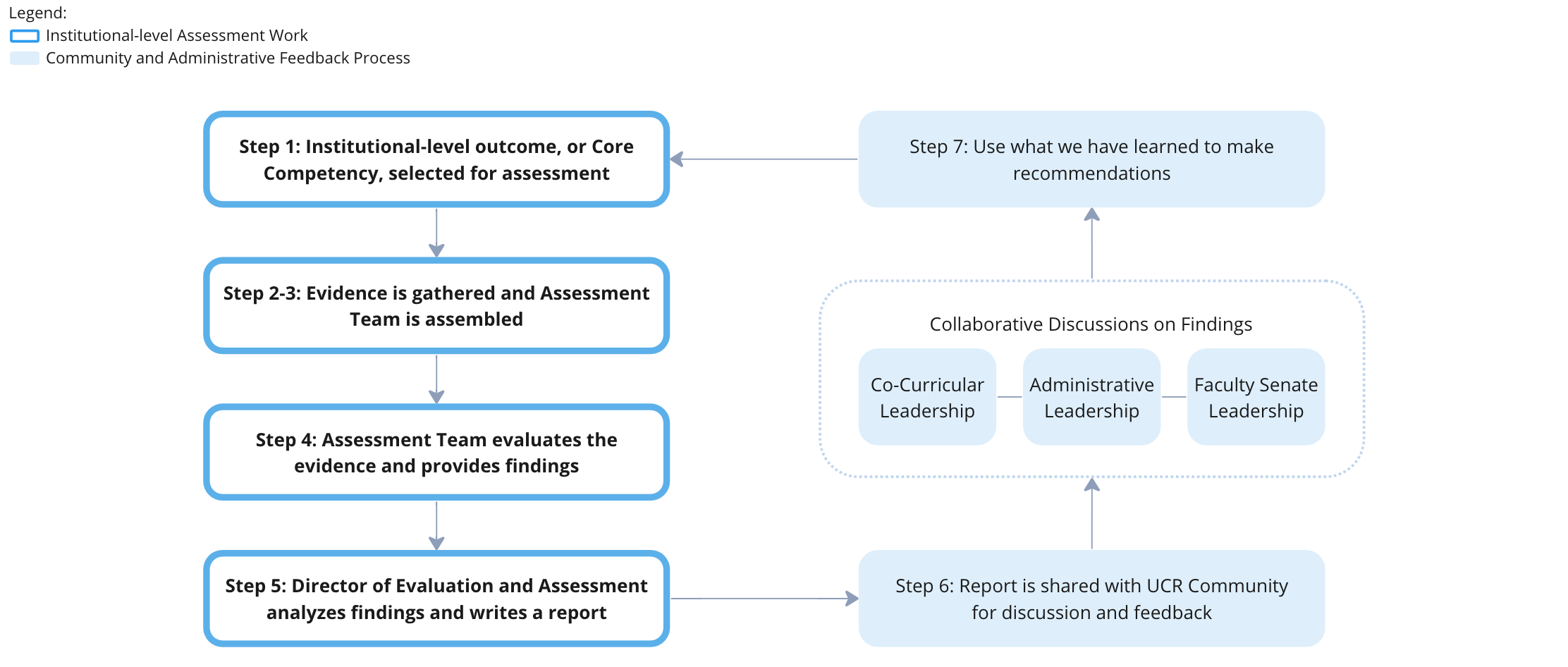Institutional-Level Assessment Overview
Assessment at the institutional level is a collaborative process that is about understanding UCR as a whole. Annually, the Office of Evaluation and Assessment collaboratively guides the following process with the Assessment Advisory Committee:
- Collects data from across the campus.
- Puts together a team that assesses the evidence collected
- Analyzes the findings of the assessment
- Produces a report to be shared with UCR Leadership
While much of the assessment process at the institutional level mirrors that of program-level assessment, there are some slight differences. At the program level, the entire process exists at the program-level from data collection to reflection and next steps. At the institutional level, data collection, assessment, and analysis happen with the institutional-level team that participates in that year, but the sharing and next steps are done collaboratively with leadership from across the campus.
At the institutional level, we assess the following outcomes - WASC Core Competencies:
- Critical Thinking
- Information Literacy
- Quantitative Reasoning
- Written Communication
- Oral Communication
For more information about the WASC Core Competencies, click on the following WASC Core Competency FAQs
For answers to common questions about UCR's institutional-level assessment of WASC Core Competencies, click on the following Institutional-Level Assessment FAQs
Institutional-Level Assessment Steps
More details on each step can be found below the diagram.
-
Step 1: Identify Outcome to be Assessed
- The timeline for assessing the Institutional-level assessment timeline of each Core Competency was established in 2019 through the Assessment Advisory Committee.
- Please refer to the General Core Competency Assessment Timeline for information on when each Competency will be assessed.
-
Step 2: Gather Evidence of Student Achievement of Outcome
- Each quarter, an email will be sent out to all faculty teaching courses relevant to the Core Competency being assessed that year with instructions on how to submit student work for the assessment.
- The Director of Evaluation and Assessment will reach out to members of the UCR community for indirect data to inform the assessment.
-
Step 3: Put Together the Team
- Senate will request faculty to participate on the assessment team for that year.
- The Director of Evaluation and Assessment will seek out staff with subject matter expertise to join the team. For example, UCR librarians will support the assessment of Information Literacy.
- In total, the team will comprise of approximately 10 Senate faculty and staff including the Director of Evaluation and Assessment.
-
Step 4: Assess the Evidence
- The team will assess a random sample of student work using a common rubric, such as the AAC&U VALUE Rubrics.
-
Step 5: Analyze the Evidence
- The Director of Evaluation and Assessment will gather the scores from each member of the team and analyze them for trends.
- The Director of Evaluation and Assessment will analyze the indirect data gathered regarding the outcome being assessed to inform the findings from the assessment of student work.
- The findings from the analyses will be compiled in a report.
- Step 6: Share Results
-
Step 7: Using What We Have Learned
- The Director of Evaluation and Assessment will work with the UCR community to develop next steps and help to implement them. Of primary importance to this step in the process will the Faculty Senate and the committees deemed most relevant to the outcome being assessed.
